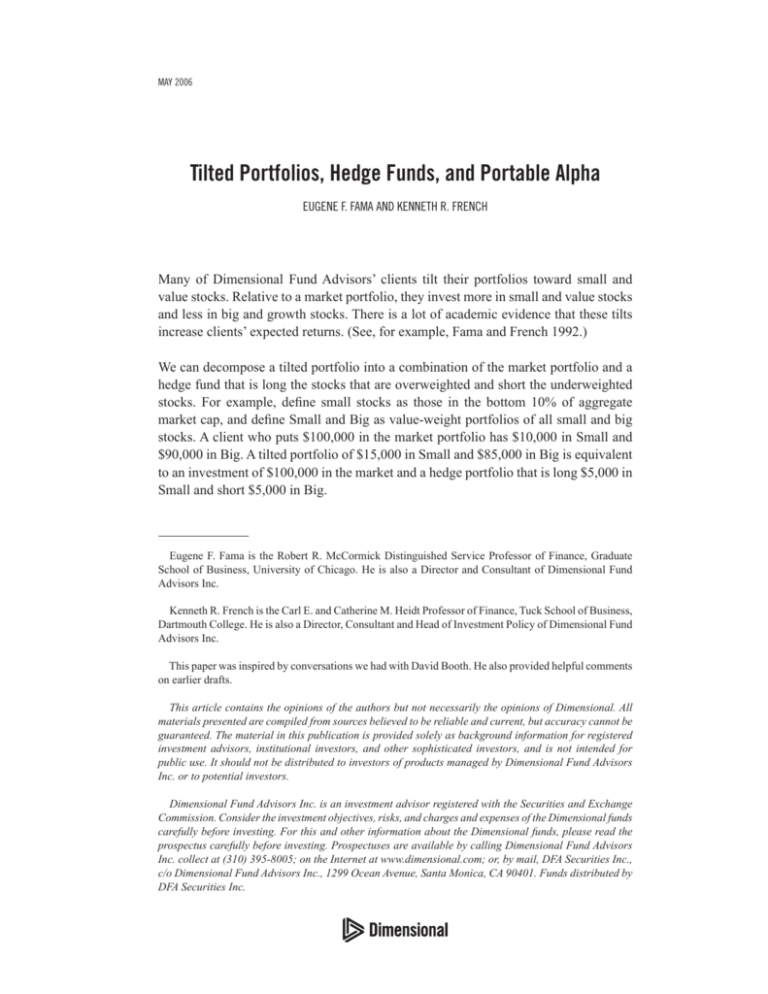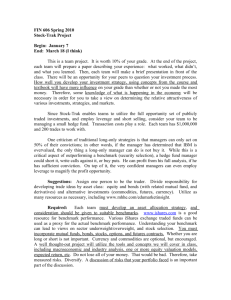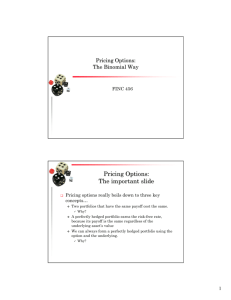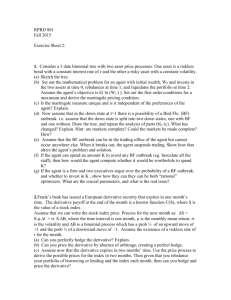Tilted Portfolios, Hedge Funds, and Portable Alpha
advertisement

MAY 2006 Tilted Portfolios, Hedge Funds, and Portable Alpha EUGENE F. FAMA AND KENNETH R. FRENCH Many of Dimensional Fund Advisors’ clients tilt their portfolios toward small and value stocks. Relative to a market portfolio, they invest more in small and value stocks and less in big and growth stocks. There is a lot of academic evidence that these tilts increase clients’ expected returns. (See, for example, Fama and French 1992.) We can decompose a tilted portfolio into a combination of the market portfolio and a hedge fund that is long the stocks that are overweighted and short the underweighted stocks. For example, define small stocks as those in the bottom 10% of aggregate market cap, and define Small and Big as value-weight portfolios of all small and big stocks. A client who puts $100,000 in the market portfolio has $10,000 in Small and $90,000 in Big. A tilted portfolio of $15,000 in Small and $85,000 in Big is equivalent to an investment of $100,000 in the market and a hedge portfolio that is long $5,000 in Small and short $5,000 in Big. Eugene F. Fama is the Robert R. McCormick Distinguished Service Professor of Finance, Graduate School of Business, University of Chicago. He is also a Director and Consultant of Dimensional Fund Advisors Inc. Kenneth R. French is the Carl E. and Catherine M. Heidt Professor of Finance, Tuck School of Business, Dartmouth College. He is also a Director, Consultant and Head of Investment Policy of Dimensional Fund Advisors Inc. This paper was inspired by conversations we had with David Booth. He also provided helpful comments on earlier drafts. This article contains the opinions of the authors but not necessarily the opinions of Dimensional. All materials presented are compiled from sources believed to be reliable and current, but accuracy cannot be guaranteed. The material in this publication is provided solely as background information for registered investment advisors, institutional investors, and other sophisticated investors, and is not intended for public use. It should not be distributed to investors of products managed by Dimensional Fund Advisors Inc. or to potential investors. Dimensional Fund Advisors Inc. is an investment advisor registered with the Securities and Exchange Commission. Consider the investment objectives, risks, and charges and expenses of the Dimensional funds carefully before investing. For this and other information about the Dimensional funds, please read the prospectus carefully before investing. Prospectuses are available by calling Dimensional Fund Advisors Inc. collect at (310) 395-8005; on the Internet at www.dimensional.com; or, by mail, DFA Securities Inc., c/o Dimensional Fund Advisors Inc., 1299 Ocean Avenue, Santa Monica, CA 90401. Funds distributed by DFA Securities Inc. Dimensional Fund Advisors Inc. 2 Original Portfolio Market Portfolio $15,000 $10,000 Long $5,000 85,000 90,000 Short 5,000 $100,000 $100,000 Small Big Total Value Hedge Portfolio $0 This is a general result. We can always decompose a portfolio into its benchmark plus a hedge portfolio of the deviations from the benchmark. Note that the hedge portfolio in our example requires no net investment. The long position in small stocks is financed by shorting big stocks. This is also a general result. Because every extra dollar spent overweighting some stocks in the original portfolio must come from underweighting others, the hedge portfolio that reproduces the original portfolio’s deviations from the market (or any other benchmark) always requires no net investment. (In fact, zero net investment is what academics mean when we say something is a hedge portfolio.) Hedge portfolios like this are at the heart of what is called portable alpha. An active manager tries to add value by deviating from the benchmark, underweighting some stocks and overweighting others. The hedge portfolio of his under- and overweights is his contribution to the investor’s overall return. Thus, the argument goes, by decomposing his portfolio into the benchmark and a hedge portfolio, an investor can get his market exposure from one manager and his alpha from another. This logic leads to a natural question. Why doesn’t Dimensional offer hedge funds that would give clients unadulterated exposure to the size and value premiums? The simple answer, developed in more detail below, is that mutual funds are a more flexible and lower-cost medium for obtaining the tilts than hedge funds, at least as typically constructed. The Three-Factor Model The three-factor model of Fama and French (1993) describes stock returns in terms of the returns on the market portfolio and two hedge portfolios, Rjt – Rft = aj + bj(RMt – Rft) + sjSMBt + hjHMLt + ejt. In this equation, Rjt is the return for period t on portfolio j, RMt is the market return, and Rft is the risk-free (Treasury bill) return. SMBt is the return on a diversified portfolio of small stocks minus the return on a diversified portfolio of big stocks. HMLt is the return on a diversified portfolio of high book-to-market (value) stocks minus the return on a diversified portfolio of low book-to-market (growth) stocks. The coefficients bj, sj, and hj are sensitivities, or loadings, or exposures to the three risk factors. The residual ejt is (by definition) random noise in the return on j for period t; and aj, the “alpha” of Tilted Portfolios, Hedge Funds, and Portable Alpha 3 the three-factor model, is the average return on j that is not explained by the exposures of the return on j to the three risk factors. If the model captures expected returns, aj should be zero for all securities and portfolios. The size (SMBt) and value/growth (HMLt) returns in the three-factor model can be viewed as hedge fund returns. Thus, SMBt can be viewed as the return on a hedge fund that is long small stocks and finances this position by shorting big stocks. Similarly, HMLt can be viewed as the return on a hedge fund that is long value stocks, financing this position by shorting growth stocks. In terms of average returns, SMBt and HMLt hedge funds are attractive. For the seventynine years from 1927 to 2005, the average SMBt return is 3.72% per year and the average HMLt return is 5.01% per year. The SMBt and HMLt returns also are not highly correlated with the overall stock market return, so they are largely market neutral. On a year-to-year basis, however, the returns have lots of volatility. The standard deviation of the annual SMBt return is 14.47% and the standard deviation of the HMLt return is 13.95%. This volatility is to be expected; in an efficient market, high expected returns come at the expense of high risks. The Fama/French story is that the size and value premiums in average returns are rewards for bearing risk. And the fact that the SMBt and HMLt returns are quite volatile is a general characteristic of market-neutral hedge fund returns. Hedge Fund Problems What is the most efficient way to trade risk for expected return? We argue that hedge funds are not the answer. The first problem with hedge funds is the high cost of shorting stocks. SMB and HML funds would be short big and growth stocks, respectively, and these short positions would involve substantial trading and holding costs. Moreover, for most and perhaps all of our investors, the costs of shorting would be completely wasted. The short positions would just reverse long positions in the rest of their portfolio. The portfolio we describe above, for example, is long $90,000 in big stocks (in the market portfolio) and short $5,000 in the same stocks (in the hedge fund). It is hard to justify the high costs of simultaneously buying and shorting the same big stocks, or of maintaining offsetting long and short positions. It gets worse. If Dimensional were to offer SMB and HML hedge funds, the management fees would have to be at least twice the fees for existing mutual funds in similar size ranges. The reason is that both the long and short positions of hedge funds must be managed, and managing the short side is at least as costly, in terms of Dimensional’s time and effort (trading, monitoring, etc.) as managing the long side. Again, if one does not want a net short position in big stocks or growth stocks, it is cheaper to build a portfolio with long positions in Dimensional’s existing mutual funds. 4 Dimensional Fund Advisors Inc. But even twice our usual fees would be far below the norm for the hedge fund industry. Hedge funds commonly charge a 2% management fee and they take, as an additional reward, 20% of any returns above a modest benchmark such as LIBOR. (Nice work if you can get it, and many of our students try!) Why would any investor pay these fees to obtain a size or value tilt if equivalent tilts can be obtained via Dimensional’s low-fee mutual funds? Fama posed this question to one of his students operating an HML-type hedge fund. The response was logical. Paraphrasing a bit, “We charge 2% because we lever HML four times, so our investors get four times the HML return for every dollar invested.” This response raises a real-world complication we have been ignoring. Our conceptual hedge portfolios require no net investment; in the example above, the $5,000 short position in Big finances the $5,000 investment in Small. Of course, real hedge funds take real cash from investors. If we use a leverage ratio of four, a hedge fund that is long $5,000 and short $5,000 implies an investment of $1,250, which is used as margin collateral or invested in relatively riskless assets. Leverage usually increases a hedge fund’s expected return. (The exception, which may be more prevalent than investors realize, occurs if the expected return on the short position is higher than the expected return on the long.) With 400% leverage, the HML average return of about 5% per year becomes 20%. The cash, which is typically invested in Treasuries and other low-risk assets that can be used as collateral, contributes a bit more. The fund’s high expected return is the good news. The bad news is that leverage also magnifies the volatility of the fund’s return. Levering an HML fund by a factor of four pushes the annual standard deviation from an already large number, about 14% per year, to an impressive 56% per year. This is blowout territory. An HML return two standard deviations below the mean wipes out a hedge fund with 400% leverage. Less extreme low returns are also likely to kill the fund. The problem is that the hedge fund’s investors are likely to flee en masse when returns are poor. In an ideal world with no transaction costs and perfect liquidity, the calculated HML premium fully incorporates these bad outcomes. But hedge funds don’t live in an ideal world. When growth returns are high and value returns are low, margin calls can force the HML manager to liquidate positions. Unfortunately, these liquidations often occur under duress, with extremely high trading costs and at distressed prices. We ignore the expected cost of such fire sales when we use four times the HML premium to estimate the fund’s expected return. Investors in the fund can exacerbate the problem. If there is a chance the fund will be forced to liquidate positions under duress, every investor wants to be the first one out, while the costs are still modest. Thus, the threat of distress costs can lead to a run on the fund, in which relatively modest losses trigger a stampede for the exits. The obvious result is even more distress costs. Tilted Portfolios, Hedge Funds, and Portable Alpha 5 For concrete perspective on this issue, Figure 1 plots annual returns from 1927 to 2005 for a hedge fund that levers HML four times. (The fund return is just HML times four.) The levered fund self-destructs (returns are less than -100%) three times during the period, 1934, 1980, and 1999. We suspect that runs on the levered fund would also cause it to bomb in the five additional years when its return is below -50%. In the end, the fund is likely to die in eight of seventy-nine sample years, or about 10% of the time. (According to the academic literature on survival rates among hedge funds, this estimate of the likely death rate is not high.) And if the coffin needs another nail, the returns shown in Figure 1 are before fees and expenses. The 2% annual management fee drops hedge fund returns by this amount every year, and taking 20% of the returns above LIBOR shrinks the expected payoff even more. Figure 1 Levered HML (x4) Returns ��� ��� ������ ��� �� � ��� ���� ���� ���� ���� ���� ���� ���� ���� ���� ���� ���� ���� ���� ���� ���� ���� ���� ���� ���� What attracts investors to high-leverage hedge funds? The answer is clear from Figure 1. Leverage is as powerful on the upside as on the downside. There are many years, and often several years in a row, when the levered hedge fund in Figure 1 has spectacular returns. For example, in eight of seventy-nine years (most recently in 2000), the return on the levered fund exceeds 90%. Over the last six years, the returns of the levered fund are less than 30% just once. Given the way investors chase returns, one can confidently predict massive flows into levered hedge funds after such spectacular performance. In sum, even when the target portfolios of Dimensional clients involve tilts toward small stocks and/or value stocks, we doubt that the targets commonly (if ever) involve 6 Dimensional Fund Advisors Inc. short positions in big stocks or growth stocks. Thus, because of their short positions, SMB and HML hedge funds (even hedge funds that are not levered) are an inefficient way to obtain tilts toward small and value stocks. When SMB and HML hedge funds are highly levered (to justify high fund management fees), a strong caveat emptor is appropriate: when bad luck strikes, investments in such funds are likely to be hazardous to your wealth. Finally, if you would like to see a careful study of the historical performance of hedge funds, we recommend “Hedge Funds: Risk and Return,” by Malkiel and Saha (2005). References Fama, Eugene F. and Kenneth R. French. 1992. The cross-section of expected stock returns. Journal of Finance 47 (June): 427-465. ———. 1993. Common risk factors in stock and bond returns. Journal of Financial Economics 33 (1): 3-56. Malkiel, Burton G. and Atanu Saha. 2005. Hedge funds: Risk and return. Financial Analysts Journal 61 (November/December): 80-88. Available in http://www.cfapubs .org/doi/pdfplus/10.2469/faj.v61.n6.2775.









